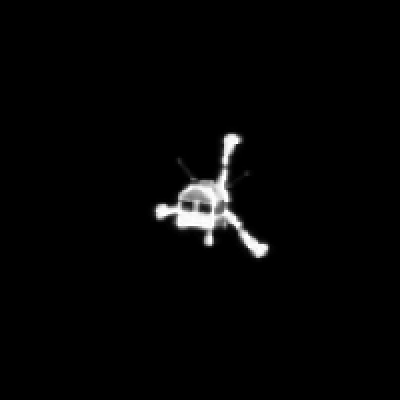Artist's impression of Rosetta's lander Philae on the surface of comet 67P/Churyumov-Gerasimenko. Image via ESA/ATG medialab
The world-first mission from the European Space Agency (ESA), dubbed Rosetta, has hit a rocky patch (sorry).
Philae, the probe sent from Rosetta onto comet 67P, successfully disembarked from the spacecraft on Wednesday and reached the comet, sending back to Earth some incredible images along the way.
However, the landing of Philae was not as smooth as anyone at ESA would have hoped, with original reports of it bouncing twice being exactly 50pc off the mark.
“We wanted to land, we landed, then we bounced even more than we thought yesterday,” explained the lander’s co-principal investigator Jean-Pierre Bibring at today’s briefing.
“We understood that we had three flights, bounced twice and stopped in a place that we haven’t entirely located. It’s not very close to where we wanted to be, but not very far away.”

The first panoramic ‘postcard’ from the surface of a comet returned by Rosetta’s lander Philae. Image via ESA
Being lost on a giant comet is not the end of the difficulties for Philae, with the spacecraft now resting on its side, lodged in the shadows of a cliff or large boulder.
With it being space, shadows are bad news, meaning Philae cannot get enough sunlight to maintain power much longer.
What’s next for the Rosetta mission?
Stephan Ulamec, Philae lander manager, said: “The drill has been active today, whether it will sample and will succeed in bringing these samples to ovens we shall know this evening.
“This would be fantastic but it is not secured – maybe the battery will be empty before we get contact again.”
Back to work! I’m now drilling into the surface of #67P… I’ll give you updates as soon as I can! #CometLanding
— Philae Lander (@Philae2014) November 14, 2014
As reported by the BBC, the ESA team said the solar panels on the lander are getting small amounts of sunlight, but not enough to maintain operations beyond Saturday.
“We plan to rotate the lander a little bit so that at the position where we have now this one panel that gets sun, we’ll have a slightly larger panel and this would increase the chance that at a later stage the lander could wake up again and start talking to us again,” Ulamec added.

Descent to the surface of a comet. Image via ESA
Meanwhile, The Guardian’s live coverage of the Rosetta mission reports that battery power will last long enough for tonight’s data transmission from Philae between 9pm and 11pm GMT.
“ESA is considering whether to spin Philae’s flywheel (designed to keep the craft upright during flight) to ‘bounce’ the lander into a new position where its solar arrays will get more sunlight to recharge its batteries,” the newspaper reported.
“Eighty to 90pc of the intended science will have been carried out, but there’s some doubt over whether all the data will be uploaded before the lander loses all power. All the lander’s instruments are working well. MUPUS and APXS instruments were used last night and the drill was activated.”
ESA will know this evening whether drill samples have been taken successfully. We won’t know until tomorrow whether or not the spacecraft can self-right itself by using its drill, flywheel or anything else that can help out.
In the meantime, for anyone who is wondering how a spacecraft can get lost on a rock, perhaps this Star Trek-themed scale can help out. It’s not a real photo.
Rosetta’s comet in Star Trek scale. A decent-sized boulder. pic.twitter.com/gPvKVNNkTN
— Andrew Rader (@marsrader) November 13, 2014